A) 7.9 N/C
B) 3.9 N/C
C) 0.49 N/C
D) 0.031 N/C
Correct Answer

verified
Correct Answer
verified
Multiple Choice
A proton is placed in an electric field of intensity 700 N/C.What are the magnitude and direction of the acceleration of this proton due to this field? (mproton = 1.67 × 10-27 kg,e = 1.60 × 10-19C)
A) 6.71 × 109 m/s2 opposite to the electric field
B) 6.71 × 1010 m/s2 opposite to the electric field
C) 6.71 × 1010 m/s2 in the direction of the electric field
D) 67.1 × 1010 m/s2 opposite to the electric field
) 67.1 × 1010 m/s2 in the direction of the electric field
Correct Answer

verified
Correct Answer
verified
Multiple Choice
A small glass bead has been charged to 8.0 nC.What is the magnitude of the electric field 2.0 cm from the center of the bead? (k = 1/4πε0 = 8.99 × 109 N • m2/C2)
A) 1.8 × 105 N/C
B) 3.6 × 103 N/C
C) 1.4 × 10-3 N/C
D) 3.6 × 10-6 N/C
Correct Answer

verified
Correct Answer
verified
Multiple Choice
A point charge Q = -500 nC and two unknown point charges,q1 and q2,are placed as shown in the figure.The electric field at the origin O,due to charges Q,q1 and q2,is equal to zero.The charge q1 is closest to 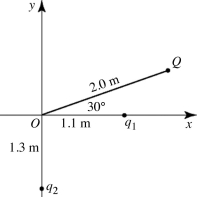
A) 130 nC.
B) 76 nC.
C) 150 nC.
D) -76 nC.
E) -130 nC.
Correct Answer

verified
Correct Answer
verified
Multiple Choice
Two point charges of +20.0 μC and -8.00 μC are separated by a distance of 20.0 cm.What is the magnitude of electric field due to these charges at a point midway between them? (k = 1/4πε0 = 8.99 × 109 N • m2/C2)
A) 25.2 × 106 N/C directed toward the negative charge
B) 25.2 × 106 N/C directed toward the positive charge
C) 25.2 × 105 N/C directed toward the negative charge
D) 25.2 × 105 N/C directed toward the positive charge
E) 25.2 × 104 N/C directed toward the negative charge
Correct Answer

verified
Correct Answer
verified
Multiple Choice
A point charge Q of mass 8.50 g hangs from the horizontal ceiling by a light 25.0-cm thread.When a horizontal electric field of magnitude 1750 N/C is turned on,the charge hangs away from the vertical as shown in the figure.The magnitude of Q is closest to 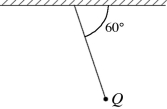
A) 27.5 µC.
B) 47.6 µC.
C) 55.0 µC.
D) 3.0 µC.
E) 3.5 µC.
Correct Answer

verified
Correct Answer
verified
Multiple Choice
A long,thin rod parallel to the y-axis is located at x = -1.0 cm and carries a uniform linear charge density of +1.0 nC/m.A second long,thin rod parallel to the z-axis is located at x = +1.0 cm and carries a uniform linear charge density of -1.0 nC/m.What is the net electric field due to these rods at the origin? (ε0 = 8.85 × 10-12 C2/N • m2)
A) (-3.6 × 103 N/C) ![]()
B) (1.8 × 103 N/C) ![]()
C) (-1.8 × 103 N/C) ![]()
D) (3.6 × 103 N/C) ![]()
E) zero
Correct Answer

verified
Correct Answer
verified
Short Answer
In the figure,a proton is projected horizontally midway between two parallel plates that are separated by 0.50 cm.The electrical field due to the plates has magnitude 610,000 N/C between the plates away from the edges.If the plates are 5.60 cm long,find the minimum speed of the proton if it just misses the lower plate as it emerges from the field.(e = 1.60 × 10-19 C,ε0 = 8.85 × 10-12 C2/N • m2,
mel = 9.11 × 10-31 kg) 
Correct Answer

verified
Correct Answer
verified
Multiple Choice
A small sphere with a mass of 441 g is moving upward along the vertical +y-axis when it encounters an electric field of 5.00 N/C  . If,due to this field,the sphere suddenly acquires a horizontal acceleration of 13.0 m/s2
. If,due to this field,the sphere suddenly acquires a horizontal acceleration of 13.0 m/s2
 ,what is the charge that it carries?
,what is the charge that it carries?
A) 1.15 C
B) -1.15 C
C) 1150 C
D) -1150 C
Correct Answer

verified
Correct Answer
verified
Multiple Choice
Three equal negative point charges are placed at three of the corners of a square of side d as shown in the figure.Which of the arrows represents the direction of the net electric field at the center of the square? 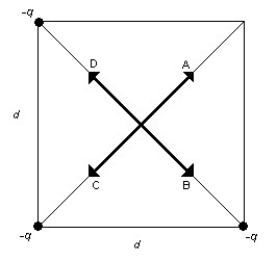
A) A
B) B
C) C
D) D
E) The field is equal to zero at point P.
Correct Answer

verified
Correct Answer
verified
Multiple Choice
A dipole with a positive charge of 2.0 μC and a negative charge of -2.0 μC is centered at the origin and oriented along the x-axis with the positive charge located to the right of the origin.The charge separation is 0.0010 m.Find the electric field due to this dipole at the point x = 4.0 m,y = 0.0 m. (k = 1/4πε0 = 8.99 × 109 N • m2/C2)
A) 0.56 ![]() N/C
N/C
B) -0.56 ![]() N/C
N/C
C) 0.28 ![]() N/C
N/C
D) -0.28 ![]() N/C
N/C
Correct Answer

verified
Correct Answer
verified
Multiple Choice
A 3.0-μC positive point charge is located at the origin and a 2.0 μC positive point charge is located at X = 0.00 m,y = 1.0 m. Find the coordinates of the point where the net electric field strength due to these charges is zero.
A) x = 0.00 m, y = 0.55 m
B) x = 0.00 m, y = 0.67 m
C) x = 0.00 m, y = 1.5 m
D) x = 0.00 m, y = 0.60 m
Correct Answer

verified
Correct Answer
verified
Multiple Choice
In the figure,a ring 0.71 m in radius carries a charge of + 580 nC uniformly distributed over it.A point charge Q is placed at the center of the ring.The electric field is equal to zero at field point P,which is on the axis of the ring,and 0.73 m from its center.(ε0 = 8.85 × 10-12 C2/N • m2) The point charge Q is closest to 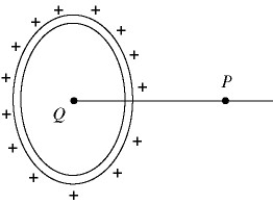
A) -210
B) -300
C) -420
D) 210
E) 300
Correct Answer

verified
Correct Answer
verified
Multiple Choice
The figure shows three electric charges labeled Q1,Q2,Q3,and some electric field lines in the region surrounding the charges.What are the signs of the three charges? 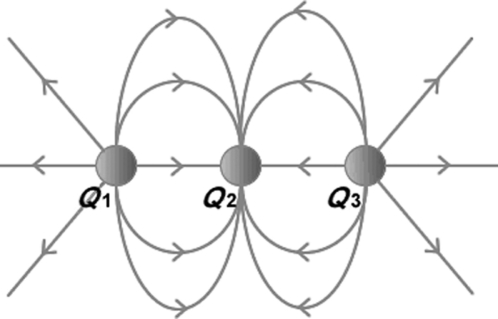
A) Q1 is positive, Q2 is negative, Q3 is positive.
B) Q1 is negative, Q2 is positive, Q3 is negative.
C) Q1 is positive, Q2 is positive, Q3 is negative.
D) All three charges are negative.
E) All three charges are positive.
Correct Answer

verified
Correct Answer
verified
Showing 21 - 34 of 34
Related Exams